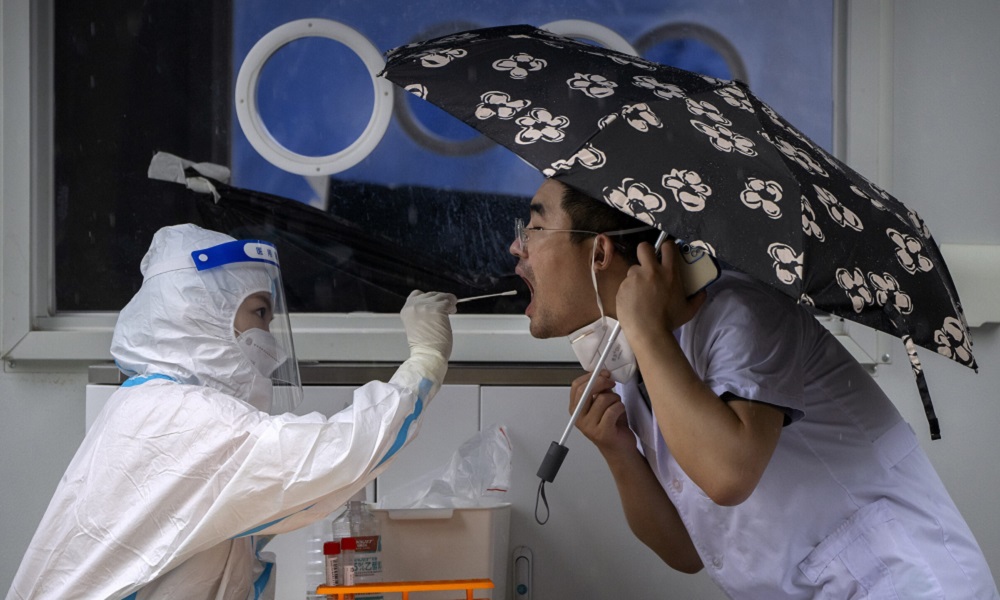COVID-19
Indian hospitals turn away patients in COVID-19 ‘tsunami’

Overwhelmed hospitals in India begged for oxygen supplies on Saturday as the country’s coronavirus infections soared again overnight in a “tsunami” of disease, setting a new world record for cases for the third consecutive day, Reuters reported.
Max Healthcare, which runs a network of hospitals in north India, tweeted that it had less than two hours of oxygen left while Fortis Healthcare, another big chain, said it was suspending new admissions in Delhi.
“We are running on backup, waiting for supplies since morning,” Fortis said.
India is in the grip of a rampaging second wave of the pandemic, hitting a rate of one COVID-19 death in just under every four minutes in Delhi as the capital’s underfunded health system buckles, Reuters reported.
The government has deployed military planes and trains to get oxygen to Delhi from the far corners of the country and overseas including Singapore.
The number of cases across the country of around 1.3 billion rose overnight by 346,786, the Health Ministry said, for a total of 16.6 million cases, including 189,544 deaths.
COVID-19 deaths rose by 2,624 over the past 24 hours, the highest daily rate for the country so far. Crematoriums across Delhi said they were full up and asked grieving families to wait.
Hospitals in Delhi have gone to the city’s high court this week seeking it to order the state and federal governments to make emergency arrangements for medical supplies, mainly oxygen.
“It’s a tsunami. How are we trying to build capacity?” the Delhi high court asked the state and federal governments in response to this plea.
Television showed families tending to the sick in hospital corridors and streets as they waited for medical attention, Reuters reported.
One man identified as Amit who was grieving for his brother at Delhi’s Jaipur Golden hospital said he had seen families running around with oxygen cylinders trying to get them refilled.
“You can’t leave me in the lurch,” a lawyer appearing for the Jaipur Golden hospital told the high court on Saturday, seeking its intervention.
The court asked the government to ensure supplies, as well to make security arrangements for medical centres amid people’s desperation.
“We know how people react, let’s not have a law and order situation,” the court said in its direction to the authorities.
India surpassed the U.S. record of 297,430 single-day infections anywhere in the world on Thursday, making it the global epicentre of a pandemic that is waning in many other countries.
The federal government had declared it had beaten back the coronavirus in February.
Health experts said India became complacent in the winter, when new cases were running at about 10,000 a day and seemed to be under control. Authorities lifted restrictions, allowing for the resumption of big gatherings.
Others said that it could also be a more dangerous variant of the virus coursing through India. It is the world’s second most populous country and people live in close proximity, often six to a room.
“While complacency in adhering to masks and physical distancing might have played a role, it seems increasingly likely that this second wave has been fuelled by a much more virulent strain,” wrote Vikram Patel, Professor of Global Health at Harvard Medical School, in the Indian Express.
Experts say the only way India can turn the tide is to ramp up vaccinations and impose strict lockdowns in the so-called red zones of high infection. It has opened up the immunisation programme to all adults but faces a shortage.
India is currently using the AstraZeneca shot and homegrown Covaxin. It has also approved Russia’s Sputnik V and has urged Pfizer Moderna and Johnson and Johnson to provide it with vaccines.
COVID-19
WHO declares end to COVID global health emergency

The World Health Organization said Friday that COVID-19 no longer qualifies as a global emergency, marking a symbolic end to the devastating coronavirus pandemic that triggered once-unthinkable lockdowns, upended economies and killed millions of people worldwide.
The announcement, made more than three years after WHO declared the coronavirus an international crisis, offers some relief, if not an ending, to a pandemic that stirred fear and suspicion, hand-wringing and finger-pointing across the globe, AP reported.
The U.N. health agency’s officials said that even though the emergency phase was over, the pandemic hasn’t finished, noting recent spikes in cases in Southeast Asia and the Middle East.
WHO says thousands of people are still dying from the virus every week, and millions of others are suffering from debilitating, long-term effects.
“It’s with great hope that I declare COVID-19 over as a global health emergency,” WHO Director-General Tedros Adhanom Ghebreyesus said.
“That does not mean COVID-19 is over as a global health threat,” he said, warning that new variants could yet emerge. Tedros noted that while the official COVID-19 death toll was 7 million, the real figure was estimated to be at least 20 million.
Tedros said the pandemic had been on a downward trend for more than a year, acknowledging that most countries have already returned to life before COVID-19.
He bemoaned the damage that COVID-19 had done to the global community, saying the pandemic had shattered businesses, exacerbated political divisions, led to the spread of misinformation and plunged millions into poverty.
When the U.N. health agency first declared the coronavirus to be an international crisis on Jan. 30, 2020, it hadn’t yet been named COVID-19 and there were no major outbreaks beyond China.
More than three years later, the virus has caused an estimated 764 million cases globally and about 5 billion people have received at least one dose of vaccine.
In the U.S., the public health emergency declaration made regarding COVID-19 is set to expire on May 11, when wide-ranging measures to support the pandemic response, including vaccine mandates, will end. Many other countries, including Germany, France and Britain, dropped most of their provisions against the pandemic last year.
When Tedros declared COVID-19 to be an emergency in 2020, he said his greatest fear was the virus’ potential to spread in countries with weak health systems.
Most recently, WHO has struggled to investigate the origins of the coronavirus, a challenging scientific endeavor that has also become politically fraught.
COVID-19
COVID-19 in Iran: Nearly 900 new cases, 24 deaths recorded

The Iranian health ministry announced on Sunday that more than 890 new cases of COVID-19 have been identified across the country during the past 24 hours, adding that 24 patients have died in the same period of time, Fars News Agency reported.
“A sum of 891 new patients infected with COVID-19 have been identified in the country based on confirmed diagnosis criteria during the past 24 hours,” the Iranian Health Ministry’s Public Relations Center said on Sunday, adding, “454 patients have been hospitalized during the same time span.”
The ministry’s public relations center said 611 people infected with COVID-19 are in critical condition.
COVID-19
China says 200 million treated, pandemic ‘decisively’ beaten

China says more than 200 million of its citizens have been diagnosed and treated for COVID-19 since it lifted strict containment measures beginning in November.
With 800,000 of the most critically ill patients having recovered, China has “decisively beaten” the pandemic, according to notes from a meeting of the ruling Communist Party’s all-powerful Politburo Standing Committee presided over by President and party leader Xi Jinping, AP reported.
China enforced some of the world’s most draconian lockdowns, quarantines and travel restrictions and still faces questions about the origins of the virus that was first detected in the central Chinese city of Wuhan in late 2019. Heavy-handed enforcement prompted rare anti-government protests and took a heavy toll on the world’s second-largest economy.
The official Xinhua News Agency quoted Xi as saying that policies to control the outbreak had been “entirely correct.” The abrupt lifting in November and December of the “zero COVID” policy that had sought to eliminate all cases of the virus led to a surge in infections that temporarily overwhelmed hospitals.
Case numbers have since peaked and life has largely returned to normal, although international travel in and out of China has yet to return to pre-pandemic levels.
China is now transitioning to a post-pandemic stage after a fight against the outbreak that was “extraordinary in the extreme,” Xinhua said.
The government will continue to “optimize and adjust prevention and control policies and measures according to the times and situations with a strong historical responsibility and strong strategic determination,” Xinhua said.
-

 Latest News4 days ago
Latest News4 days agoPakistan says India launched attack on Afghanistan, India denies
-

 World4 days ago
World4 days agoUS offers to help India and Pakistan start talks, G7 also urges dialogue
-

 Sport4 days ago
Sport4 days agoFIFA OKs creation of Afghanistan women’s refugee team
-

 Regional4 days ago
Regional4 days agoPakistan says it has launched military offensive against India
-

 World4 days ago
World4 days agoTrump says India, Pakistan agree to ‘full and immediate ceasefire’
-

 Regional3 days ago
Regional3 days agoExplosions reported after India and Pakistan agree to ceasefire
-

 Regional2 days ago
Regional2 days agoIndian air force says losses are part of combat but all pilots back home
-

 Tahawol4 days ago
Tahawol4 days agoTahawol: Status of Afghanistan’s infrastructure projects reviewed























